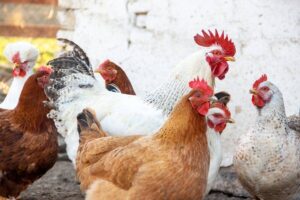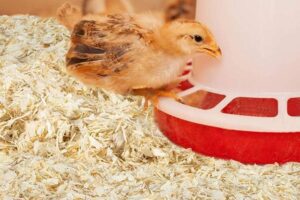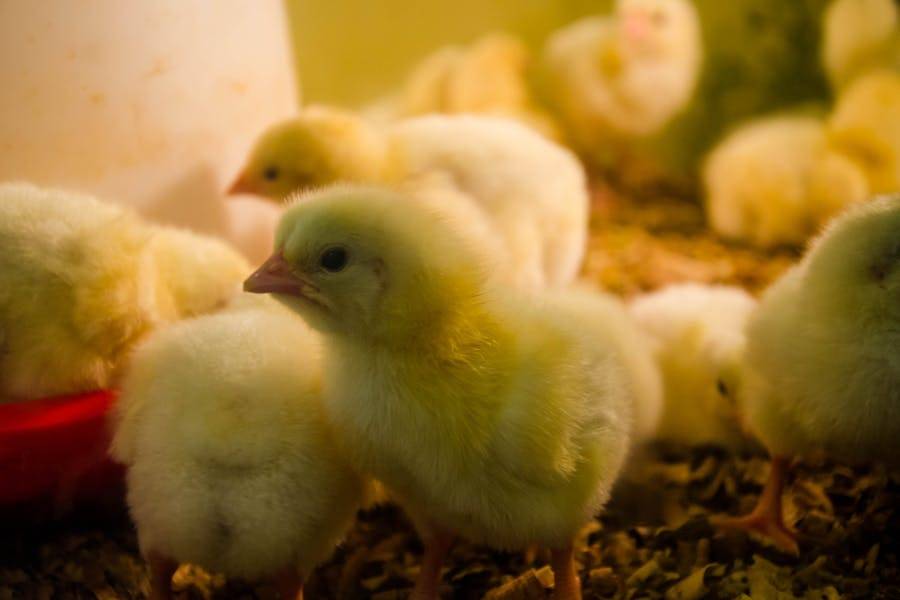Table of Contents
Pelletized bedding for chickens is a type of bedding made from compressed wood or straw particles.

These pellets are made by subjecting the raw materials to heat and pressure, which causes the natural lignins in the wood or straw to act as a binder, holding the pellet together.
Bedding is crucial for chickens as it provides a comfortable environment for them to live and lay eggs.
It also helps control odors, absorb waste, and reduce the likelihood of diseases spreading within the coop.
The Manufacturing Process of Pelletized Bedding
Raw Materials Used
The primary raw materials used for pelletized bedding are wood chips, sawdust, or straw.
These materials are sourced sustainably and are often byproducts of other industries, making this a green option for bedding.
Steps in the Production Process
The production process begins with the raw materials being dried to reduce moisture content. They are then passed through a mill to be broken down into smaller particles.
These particles are then subjected to high pressure and heat, causing the natural lignins to bind the particles together into pellets.
Benefits of Using Pelletized Bedding for Chickens
Superior Absorbency
Pelletized bedding offers superior absorbency compared to other types of bedding. These pellets can soak up to four times their weight in moisture, effectively dealing with the waste produced by your chickens.
This high level of absorbency ensures that the coop stays drier and more comfortable for your flock.
Excellent Odor Control
Another significant benefit of pelletized bedding is its excellent odor control. The pellets absorb waste efficiently, reducing the smell emanating from the coop.
This makes the environment more pleasant for both the chickens and those taking care of them.
Easy Maintenance
Pelletized bedding is relatively easy to maintain. The nature of the bedding allows you to only remove the soiled or wet pellets while leaving the rest intact.
This selective cleaning process reduces the overall bedding turnover, saving you time and effort.
Dust-Free Environment
Unlike other types of bedding like sawdust, pelletized bedding provides a virtually dust-free environment.
This is beneficial as dust can lead to respiratory problems in chickens. By choosing pelletized bedding, you’re promoting healthier living conditions for your flock.
Sustainability
Pelletized bedding is often made from recycled or waste products from other industries, such as wood chips or straw.
This makes it a sustainable choice that helps reduce waste and promotes a circular economy.
Long-Lasting
Due to its high absorbency and easy maintenance, pelletized bedding tends to last longer than other types of bedding.

This can save you money over time as you’ll need to replace the bedding less frequently.
How to Use Pelletized Bedding
Preparation of the Coop
Before introducing pelletized bedding into your chicken coop, it’s important to ensure the area is thoroughly cleaned.
Remove all old bedding and waste, then make sure the floor of the coop is completely dry. Having a clean and dry environment is essential to maximize the effectiveness of the pellets.
Activation of the Pellets
Pelletized bedding needs to be activated before use. This is done by adding water to the pellets, causing them to expand and increase in volume.
To do this, you can pour approximately one gallon of water per 40 lb bag of pellets. It’s best to add the water directly to the open bag of pellets and let them absorb the liquid.
Another method is to pour the bag of pellets into a muck bucket or similar container, add water, and let them puff up. The expansion process can take a few minutes, so patience is key.
Application in the Coop
Once the pellets have expanded, they’re ready to be spread out in the coop. The expanded bedding should be laid down to create a layer of about 1-2 inches across the floor of the coop.
It’s worth noting that you can add more bags as needed, depending on the size of the coop and the number of chickens.
Some people also recommend adding 1/2- 1 bag of unsoaked wood pellets to the base for extra absorbency.
Maintenance and Topping Up
To maintain the bedding, you’ll need to regularly remove any wet or soiled pellets and replace them with fresh ones.
You can simply add half a bag to a bag on top of the existing bedding, depending on the level of moisture present.
There’s no need to wet the new pellets; they will absorb any excess moisture from the bottom pellets.
Winter Use
During winter, pelletized bedding can be particularly beneficial. The pellets provide excellent insulation, keeping the chickens warm and dry.
The maintenance process remains the same; just ensure that the coop is adequately ventilated to prevent dampness and possible respiratory issues for the chickens.
Maintenance and Replacing the Pelletized Bedding
Regular Cleaning
Regular maintenance is required to keep the coop clean and healthy. This involves removing any wet or soiled pellets and topping up with fresh ones as needed.
When to Replace the Bedding
On average, pelletized bedding should be completely replaced every 4-6 weeks. However, this can vary depending on the number of chickens and the size of the coop.
Comparing Pelletized Bedding with Other Bedding Types
Pelletized Bedding vs. Straw
While straw is a popular choice for bedding, it doesn’t have the same level of absorbency as pelletized bedding.
It also doesn’t control odors as effectively and can harbor pests.
Pelletized Bedding vs. Wood Shavings

Wood shavings are another common choice, but they can create dust which may cause respiratory issues in chickens.
Pelletized bedding is virtually dust-free, making it a healthier option.
Pelletized Bedding vs. Sawdust
While sawdust is a readily available and inexpensive bedding option, it doesn’t measure up to pelletized bedding in several ways.
Firstly, sawdust does not have the same high level of absorbency as pelletized bedding. As a result, it may need to be changed more frequently to prevent moisture build-up.
Secondly, sawdust can potentially create a lot of dust, which could lead to respiratory problems in chickens.
Pelletized Bedding vs. Sand
Sand is another bedding option that some chicken owners use. It is excellent for drainage and easy to clean by simply scooping out like a litter box.
However, it doesn’t provide the same level of odor control as pelletized bedding. It also tends to be heavier and more challenging to manage than pelletized bedding.
Potential Drawbacks of Pelletized Bedding
Pelletized bedding can be more expensive than other types of bedding. However, due to its high absorbency and long-lasting nature, it can often work out to be more cost-effective in the long run.
If not properly maintained, wet pelletized bedding can create a damp environment, which could potentially lead to respiratory issues in chickens. Regular cleaning and maintenance are therefore crucial.
Conclusion
Pelletized bedding is a highly absorbent, odor-controlling, and sustainable choice for chicken coops. It’s easy to use and maintain, making it a convenient option for many chicken keepers.
Choosing the right bedding for your chickens is crucial for their health and productivity.
While pelletized bedding has many benefits, it’s important to consider all factors, including cost and maintenance requirements, before making a decision.









